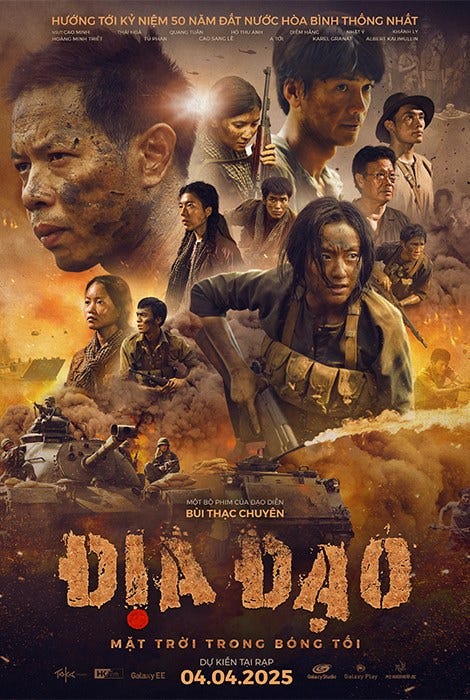Echoes in the Tunnel: Emotion, History, and the Gaps of Địa Đạo
Địa Đạo: Mặt Trời Trong Bóng Tối (The Tunnel: The Sun in the Darkness), directed by Bùi Thạc Chuyên, is a rare example of a well-crafted, emotionally resonant war film produced in Vietnam in recent years. Premiering during the 50th anniversary of the country’s reunification, the film resonated with audiences on a raw level. Acclaim has noted its suffocating tension, immersive cinematography, restrained pathos, and nationalistic spirit—without descending into overt propaganda. That achievement is real and deserves to be acknowledged.
But precisely because the movie works so well—because it touches audiences deeply—it’s also worth asking harder questions. What are we watching? Whose version of history are we absorbing? And what might we be missing?
A Smart, Strategic Framing
Set in 1967, shortly after the devastating Cedar Falls operation by the U.S. military in Cu Chi, Địa Đạo wisely avoids the more politically sensitive periods of the war. It does not address the later Tet Offensive or internal conflicts. Instead, it plunges viewers straight into a world of devastation, where a small band of guerrillas must survive underground, facing overwhelming American firepower.
From a cinematic standpoint, it’s brilliant. By starting after Cu Chi has already been obliterated from above, the film allows us to focus entirely on what remains: human resilience. There is no need to explain ideology, no need to question orders, no need to depict local ambiguity. The guerrillas are shown as humble, determined, emotionally bonded. In their darkness, they carry the light.
That enables the film to align with state narratives of patriotism, without it feeling like a propaganda film. It’s a subtle, modern approach to historical cinema—and that’s part of what makes it powerful.
But It’s Also a Version - Not the Whole
Still, we must remember: every war film is a point of view. Whether produced in Vietnam, Hollywood, Russia, or Korea, war films are shaped by what they choose to show—and what they leave out.
In the case of Cu Chi, there is much that Địa Đạo understandably avoids. Other sources—such as Tom Mangold’s The Tunnels of Cu Chi and Gordon Rottman’s Tunnel Rat in Vietnam—document difficult realities: villagers caught between sides, internal purges of suspected informants, booby traps designed for psychological terror, defectors, and long-term trauma suffered by survivors. These do not negate the bravery of the guerrillas. But they complicate it.
Watch Carefully, Feel Deeply, Question Honestly
And that is the point: complexity. The danger is not that Địa Đạo is dishonest. The danger is when emotionally compelling films are mistaken for historical truth. No matter how moving a story is, it’s still a story—curated, framed, and shaped for impact.
The power of Địa Đạo lies in its portrayal of quiet determination. But its world is unified. There are no cracks. No disagreement. No fear of the guerrillas themselves. Everyone endures, together.
History tells us otherwise. In every war—especially long and brutal ones—some people resisted, others conformed, some broke, some fled. Those silences are not less patriotic. They’re just less comfortable.
A more open Vietnam may one day tell stories not just of survival under bombs, but also of the costs of unity, the weight of silence, and the lives lived in between.
Địa Đạo deserves its audience. It is a well-made, emotionally resonant film. But as viewers—especially those who care about history—we can hold two thoughts at once:
That the story is sincere.
And that it is incomplete.
Films can move us. But only questions help us remember fully.



